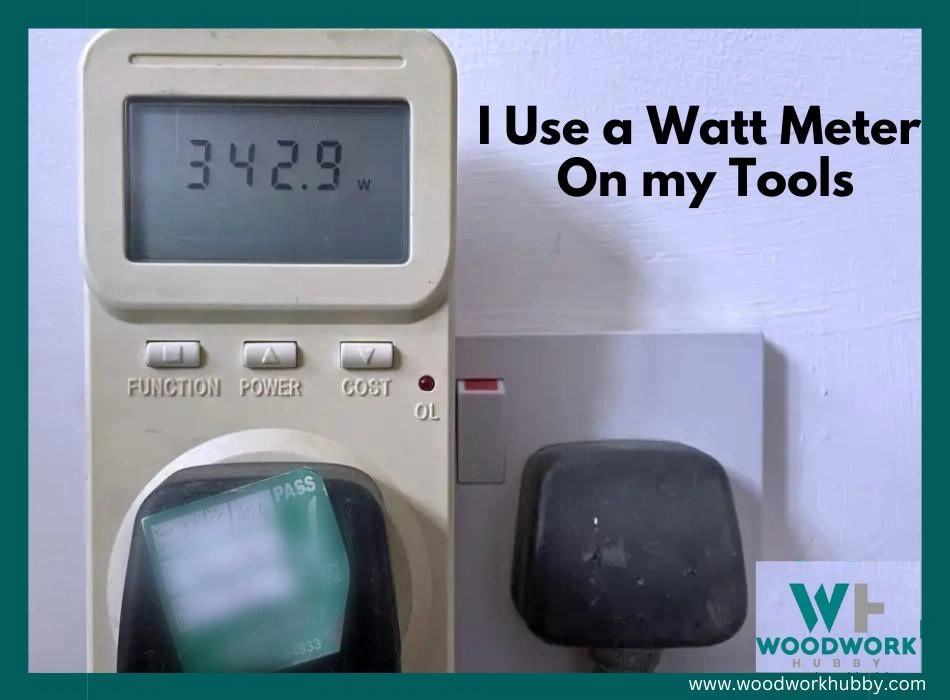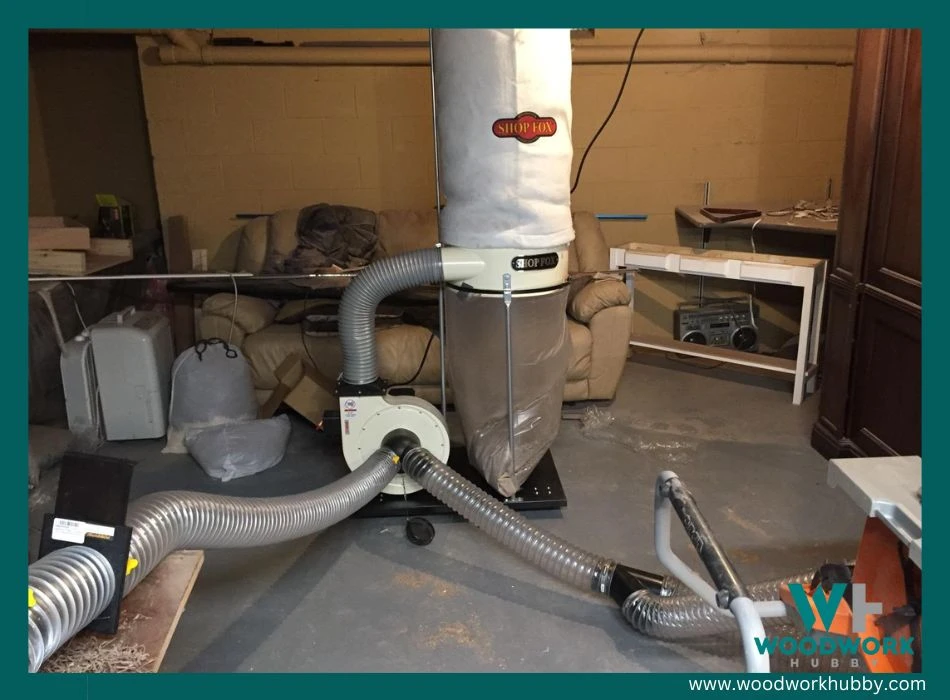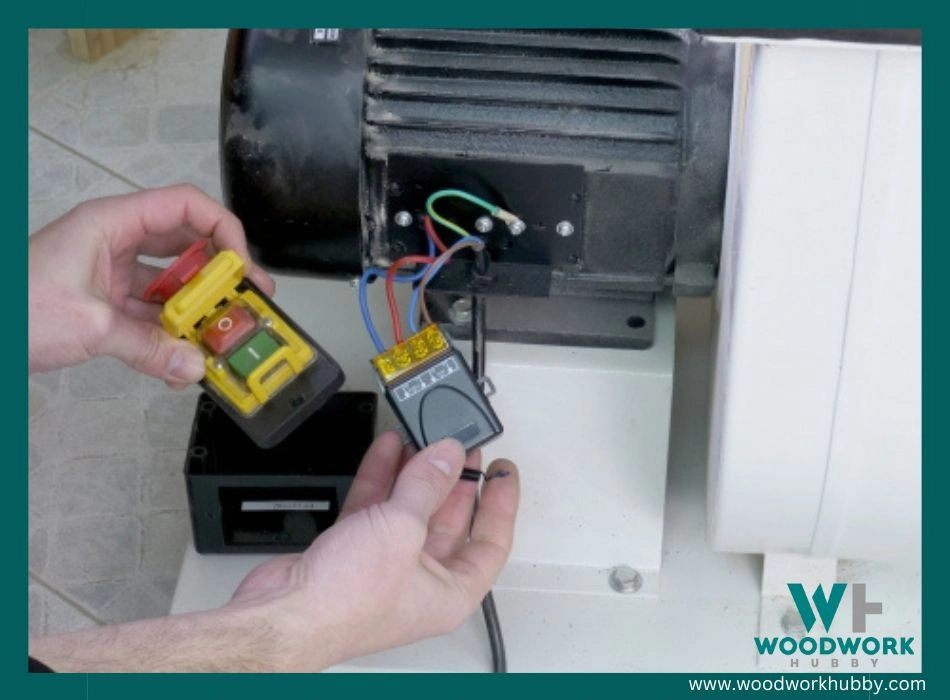Dust Collectors are a must for every workshop. The moment you graduate from hand tools to stationary cutters, sanders, and saws, you sign up for a lifetime of brooming dust if you don’t get a dust collector.
But in my more than two decades of experience working with these tools, I am fully aware that these devices can be costly to get, difficult to set up, and hard to maintain. Above all, they can use more power than you can afford if you are not careful enough. When I set up my workshop, my first question was, what are the running costs? In particular, how many watts does your dust collector use?
An average 1.5 HP to 2 HP dust collector uses 1.12 kW to 1.47 kW of electricity, respectively. But given that dust collectors that work at 3/4 HP are available on the market, as are ones with 5 HP motors, the electricity used by a dust collector depends on the individual unit.
In this article, you will learn more about individual factors that affect how much power a dust collector uses and the different wattage of specific dust collectors. By the end of this post, you will know which dust collector you should get, what kind of electric outlet it will work with, and what you can do to minimize your power bill while maintaining a clean workshop.
This information comes from my doing some tests with a power device and from my two decades of woodworking experience and a broad range of authoritative sources, so treat it as a complete guide.
Be very careful with your dust extractor setup. I have heard all the stories about dust explosions so I decided to put this myth to bed when I wrote this article on Do dust collectors need to be grounded?

The Factors That Affect A Dust Collector’s Power Usage.
It is pretty easy to glean whether a specific dust collector will use more energy or less by looking at its CFM. The CFM is the airflow, and since it is a result of the motor power, higher CFM is associated with higher power use. But CFM doesn’t actually cause the power usage to be high. It is a result of high power usage. The only two factors that affect the actual power use of your dust collector are:
- Its HP rating – HP stands for Horse Power, which is literally a unit of power. The more HP a motor uses, the more electric power it uses per hour.
- The duration of its use – Your overall energy bill can be lower with a higher HP motor if you use it less often than a lower HP motor. So aside from the HP of the dust collector, the time it stays operational is the most important factor in overall power usage.
A video showing the comparison between 2 and 3-HP dust collectors.
Watts to Dust Collector Usage, a simple formula:
Now you know that 1 HP dust collector uses 1 Horsepower (unit of energy) in 1 hour. But your electric bill isn’t priced in horsepower. To better understand how a dust collector’s HP and usage duration affect your energy bill, apply these formulae:
- HP x 0.7457 = Energy in kW. 1 Horsepower equals 0.7457 kW of energy.
- Energy in kW x Hours of use = Energy in kWh. KiloWatt Hours is the unit in which energy is priced.
- Energy Use in kWh x Cost of 1 kWh = Your energy costs for dust collector use.
You don’t have to memorize these formulae to get the energy bill estimate. I have compiled power usage data in the section below. But for clarity’s sake, I’ll take a specific model through the three formulae covered above and show you how you can do the same for any motor-powered appliance of yours.
How To Calculate Your Dust Collector Bill
Let’s suppose I have a JET JCDC-3 Cyclone Dust Collector. Here are the exact steps through which I’ll take this dust collector and get my energy bill estimate.
- Step 1 – Get the HP of your dust collector – Jet JCDC-3 has a 3 Horsepower motor. You can find your dust collector’s HP on its packaging or sales page.
- Step 2 – Multiply the HP with 0.7457 to get kW – 3 multiplied by 0.7457 equals 2.2371 kW.
- Step 3 – Multiply the kW with hours of use to get kWh – If I use my dust collector 2 hours a day, 2.2371 will be multiplied by 2, getting 4.4742 kWh per day.
- Step 4 – Get the cost of electricity per kWh – If I were based in Virginia, the average cost of electricity for me would be 13 cents per kWh.
- Step 5 – Multiply the cost of kWh with your dust collector’s kWh. – 4.4742 kWh per day multiplied by 13 cents per kWh equals 58.1646 cents per day.
How Many Watts Do Different Dust Collectors Use?

To further simplify the process covered above, I have formulated a table with different dust collectors’ kilowatt usage.
| HP of the Dust Collector | Electricity Usage Per Hour |
|---|---|
| 1 HP Dust Collector | 0.7457 kW |
| 2 HP Dust Collector | 1.4914 kW |
| 3 HP Dust Collector | 2.2371 kW |
| 4 HP Dust Collector | 2.9828 kW |
| 5 HP Dust Collector | 3.7285 kW |
What Does This Power Usage Compare To?
Given that the average shop will use a 2 HP dust collector, the kW usage as shown above of 1.4914 kW is the same as using a 1200 watt microwave for just over an hour per day.
How to use the table above to understand your bill. Once you know which dust collector you have (by HP), simply use the kW rating next to it. Multiply it by the number of hours you use it and the cost of electricity per kWh (listed on your energy bill), and you will have almost the exact amount you’re paying to run your dust collector.
That said, you have to realize that electric machinery is not 100% efficient. The actual cost of electricity with being slightly higher than your calculations because some energy is lost in operation, and you get charged for it anyway.
How Much Power Does A Dust Collector Use?
The power of a dust collector is dictated by the HP of its motor. It can affect the CFM of the dust collector but is far from
A dust collector uses 1491.4 Watts of power on average, depending on its HP and CFM. The stronger its airflow, the more power its motor uses, and the higher your electricity bill is likely to be. That said, a high-power dust collector needs to be run for a shorter period, which can save energy.
So your goal should not be to get the lowest HP dust collector but to get one that is just high enough in power and CFM to get the job done. One is the starting HP for most dust collection devices, which might make some people wonder if it is sufficient for their workshops.
Here are some of the other helpful articles I have put together during my time setting up my dust collector:
Is 1-Hp Dust Collector Enough?
1-HP dust collector is enough for a workshop that needs a 700 CFM airflow. If you have 3 stationary tools or less and your workshop area is no higher than 800 square feet, then a 1-HP dust collector will be enough.
Other than that, you cannot use such dust collectors in a primary dust clearance capacity. They can be used as secondary collectors or can be aided by a HEPA air filtering system. But as stand-alone systems, they are slightly above shop vacs in their dust collection capacity.
That is not to say that they cannot be used at all as central dust collectors. Anything that can create a vacuum can technically serve a dust collection function. Even shop vacs cannot be ruled out of this.
A video review of Delta 50-723 1 HP dust collector.
Can I Use My Shop Vac As A Dust Collector?
You can use your shop vac as a dust collector, though it will not be very efficient because of low HP, CFM, and filtering precision. It will also need changes to its assembly so it can run independently. Still, it is better than nothing.

A shop vac should be able to generate over 600 CFM before it can be considered for primary dust collection. Its collection hose needs to fit the dust collection outlet of the tool you use. Here is a video that shows how you can turn a shop vac into a dust collector.
Generally, turning your shop vac into a dust collector has a few drawbacks, mainly:
- Clogged dust hose – The low CFM of a shop vac can lead to wood chips and dust settling in the hose. This can further restrict the airflow and may even close the hose.
- A constant need to clear out the dustbag – Shop vacs aren’t designed to have the dust-carrying capacity of larger cyclones. You need to constantly clean out the dust bucket/bag over and over.
- Performance inefficiency – Homemade dust collectors aren’t as efficient as collectors designed for plug-and-play. Your shop vac will let more dust escape.
- Higher power consumption – While shop vacs don’t have as high an HP as a full-fledged dust collector, they often need to run longer to clear out the dust. This can impact your energy bill.
The last point is quite significant because the airflow of the dust collector determines how long it needs to run, especially if you run it after using your power tools. That’s why you must double-check the CFM of the dust collector you get before you get it.
How Much CFM Do I Need For A Dust Collector?
You need a 350 CFM dust collector for a 10-foot (3.05 m) table saw, 550 CFM for a horizontal sander, and 600+ CFM for higher efficiency tools that produce finer or thicker than average dust. On average, your shop should have a 700 CFM dust collector at a minimum.
Since a 10-foot (3.05 m) table saw needs just a 350 CFM dust collector, you can modify your shop vac to turn it into your primary dust collector if the only stationary tool you have is a table saw. Getting a 700 CFM dust collector will ensure that most of the tools in your shop remain free of dust when you use them.
What Voltage Do Dust Collectors Require?
Aside from knowing about the power consumption of different dust collectors and deciding the CFM you need for your workshop, you have to consider the voltage requirements too. You might be willing to pay for the energy bill that a specific dust collector may produce, but is your workshop equipped with electric outlets to even run the collector?
From this, you can glean that dust collectors can be plugged into 110 volts outlets if their CFM and HP are low enough. But on average, workshop dust collectors require 240 to 350 voltage to work.
Voltage should not be confused with wattage, though. The voltages of a device and an outlet indicate their compatibility, while the wattage tells the actual power usage. If you want to minimize your electric bill, you need to look past the voltage and onto the wattage of the device. That is why I covered how many watts different dust collectors used much earlier in this post. The rest of this article covers Watt-Hour minimizing.
How To Minimize Dust Collection Power Usage?
Now that we have covered the power in watts as well as the voltage of different types of dust collectors, let’s go over the best practices for minimizing your energy bill while keeping your shop from becoming a dusty mess. In this section, I will disclose the tips and tricks that I learned from my 20+ years of woodworking.
Get The Right Dust Collector
More isn’t always better, especially when it comes to dust collectors. Usually, a 2HP motor is more than sufficient for a mid-sized workshop. If your dust collector runs for the entire duration of your woodworking, it should not have a 3HP motor.
A 3HP motor or even a 5 HP motor works for post-work cleanup. The power usage is high, but the suction efficiency means that the dust collector needs to run for a shorter period.
Use A Remote-Controlled Dust Collector
You will be surprised by how much energy you can save by turning off your dust collector when you set aside your woodworking tool or pause the blade action. When you have to walk a long distance to pull it off, it doesn’t seem worth it, and you let the dust collector run.

Meanwhile, if you are interested to know the best dust collectors that work for basement shops, please click on the link provided.
Final Thoughts – How Many Watts Does Dust Collector Use?
Your dust collector uses anywhere between 1.12 kilowatts to 1.86 kilowatts per hour of use. If you multiply the hours of dust collector operation by the kilowatts it uses per hour, you’ll get its kilowatt-hour reading, which reflects how much you pay in your energy bill. Use a decent HP dust collector and turn it off when not in use to avoid wasting electricity.







